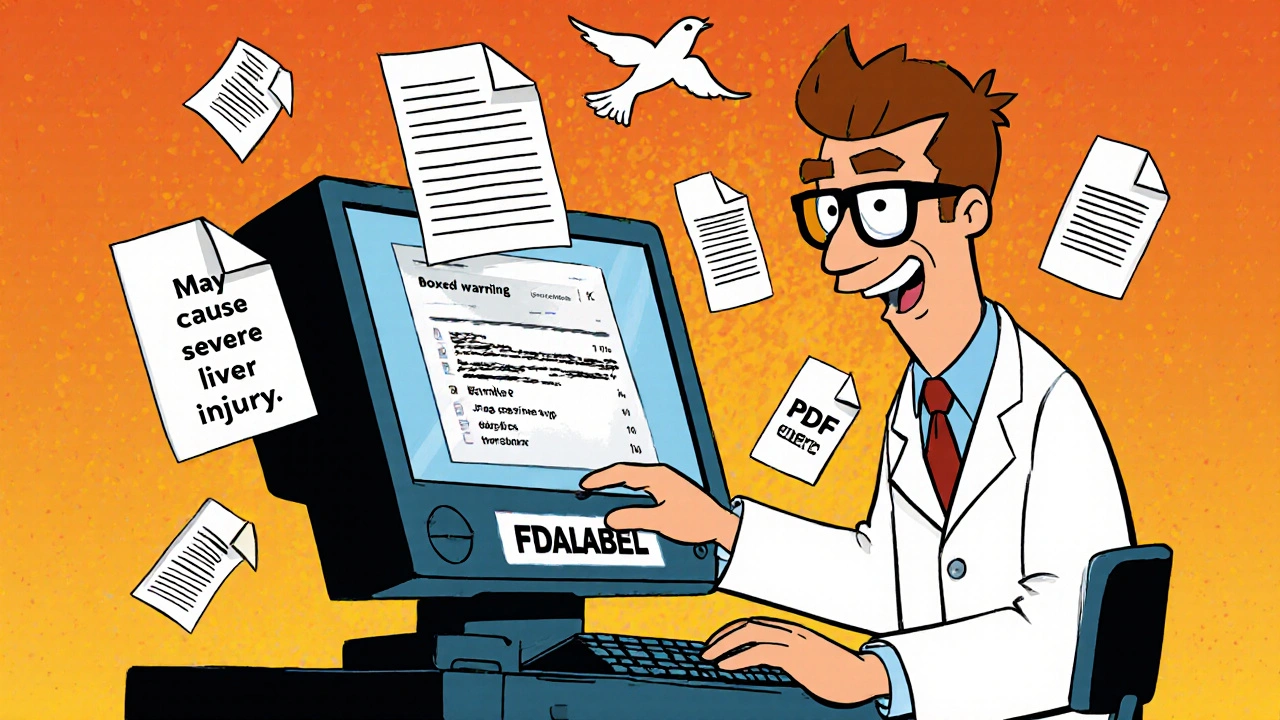
Searching for the exact wording of a drug’s boxed warning, adverse reactions, or drug interactions shouldn’t require sifting through hundreds of PDFs. If you’re a researcher, pharmacist, regulatory professional, or even a curious patient, the FDALabel Database is the only free tool that lets you search the full text of every FDA-approved drug label-fast and accurately. Unlike Drugs@FDA or DailyMed, FDALabel doesn’t just show you a list of labels. It lets you hunt down specific phrases across 149,000+ labeling documents, updated twice a month, straight from the FDA’s official archive.
What FDALabel Actually Is (And What It’s Not)
FDALabel is a web-based search engine built and maintained by the FDA’s National Center for Toxicological Research. It doesn’t sell data. It doesn’t track users. It doesn’t charge a cent. It’s a public utility for anyone who needs to find precise regulatory language in drug labels-like the exact sentence that says, "May cause severe liver injury in patients with pre-existing hepatic disease."
What it’s not: It’s not a clinical decision tool. It won’t tell you if a drug is safe for your 78-year-old diabetic aunt. It’s not a pricing database. You won’t find out how much Lisinopril costs in Ohio. It’s not a replacement for your electronic health record. It’s a deep-text search engine for Structured Product Labeling (SPL) documents-the official, machine-readable labels that drug companies submit to the FDA.
As of July 2024, FDALabel indexes over 149,000 labels covering human prescription drugs, over-the-counter medicines, biologics, and animal drugs. That’s more than double the number from 2018. Every update pulls directly from the FDA’s SPL archive, so you’re seeing the same data regulators use. No middlemen. No summaries. No filters applied by third parties.
Why FDALabel Beats Other FDA Tools
Most people know Drugs@FDA. It’s great for checking when a drug got approved, its patent status, or whether it’s branded or generic. But if you need to find all drugs that mention "QT prolongation" in their Adverse Reactions section? Drugs@FDA can’t do that.
DailyMed hosts the same SPL documents-but its search is basic. You can search by drug name or active ingredient. That’s it. No section filtering. No phrase matching. No export options beyond PDF.
FDALabel changes the game. You can search:
- Across the entire label text
- Only in Boxed Warnings
- Only in Drug Interactions
- Only in Adverse Reactions
- By pharmacologic class (e.g., "SGLT2 inhibitors")
- By MedDRA terms (standardized medical terminology for adverse events)
- By application type (NDA, ANDA, BLA)
- By product category (human Rx, OTC, animal)
For example, if you’re studying liver toxicity in diabetes drugs, you can search: "Human Prescription Drug AND NDA AND acute liver failure IN BOXED WARNING". In seconds, you get 66 results-all with direct links to the exact label sections. That’s the kind of precision you can’t get anywhere else.
How to Use FDALabel: A Step-by-Step Guide
Go to www.fda.gov/FDALabelTool (or nctr-crs.fda.gov/fdalabel). The interface is clean but dense. Here’s how to make it work for you.
- Start with the basic search box. Type a phrase like "rhabdomyolysis" and hit Enter. You’ll see a list of drugs with that term anywhere in their label.
- Narrow your search. Click "Advanced Search" to open filters. Choose "Human Prescription" and "NDA" to focus on brand-name drugs.
- Target specific sections. Under "Search Within", select "Adverse Reactions". Now you’re only looking at that section-no fluff.
- Use MedDRA terms. If you’re researching side effects, use MedDRA codes. For example, "Myocardial infarction" has MedDRA term ID 10029255. Type the term or code into the MedDRA field to find all drugs linked to that event.
- Save your search. Click "Create Permanent Query Link". Copy the URL. You can email it to a colleague, bookmark it, or reuse it later. The link will always return the same results-even if the database updates.
- Export your results. Click "Export Results". You can download as CSV (basic) or now-thanks to the July 2024 update-Excel. The Excel file includes two tabs: one with the drug data, another with the query link, result links, and export timestamp. Perfect for audits or research logs.
Pro tip: Use quotes around phrases like "increased risk of bleeding" to force exact matches. Without quotes, FDALabel will return results where "increased" and "risk" appear anywhere in the label, not together.
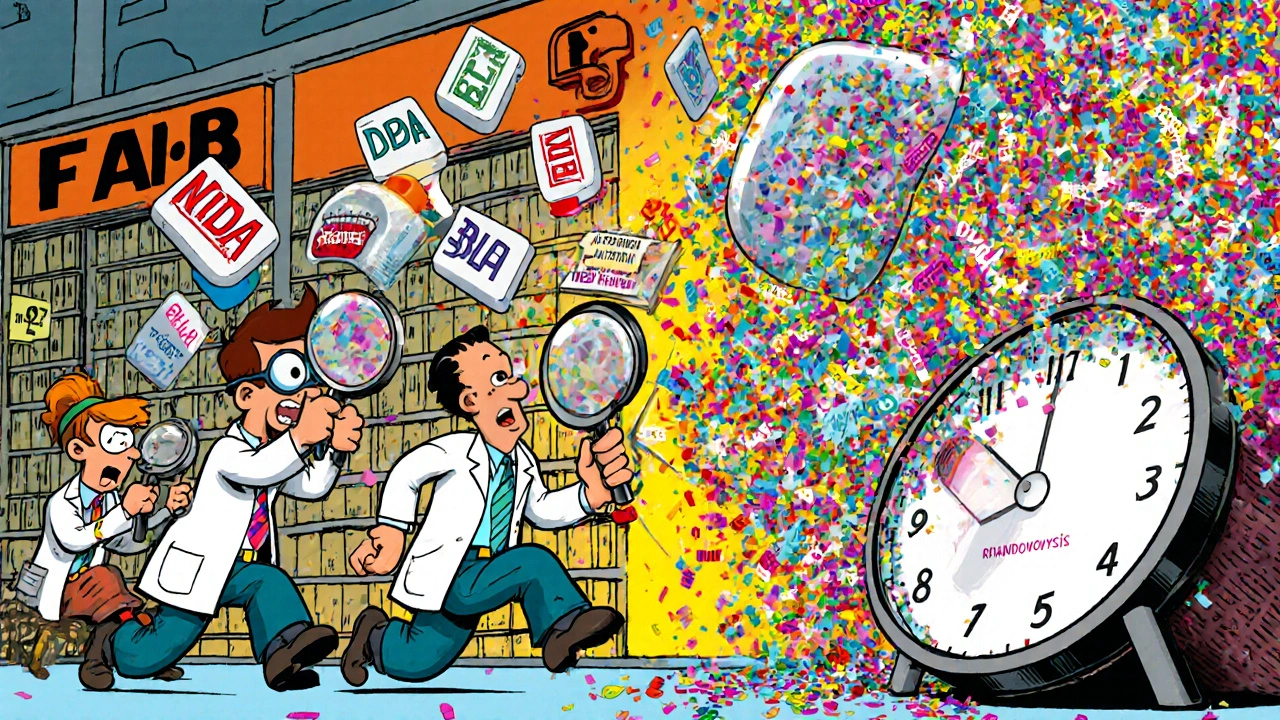
Who Uses FDALabel-and Why
Pharmaceutical companies use it to study competitor drugs. They look at the ingredients, warnings, and contraindications in labels to design similar products without infringing patents. One FDA report noted that companies have used FDALabel data to "create similar or alternative drugs by studying the ingredients present in the labeling documents."
Researchers use it for pharmacovigilance. A 2023 study in PMC (PMCID: PMC12098182) built a tool called "AskFDALabel" that combines FDALabel with AI to analyze adverse event patterns. It found that combining FDALabel’s precise data with LLMs improved the accuracy of identifying rare side effects by 40% compared to using AI alone.
Regulatory professionals rely on FDALabel for compliance. If a drug maker claims their label matches FDA guidance, FDALabel is the source of truth to verify it. It’s also used by FDA inspectors during audits.
Healthcare providers? Less common, but growing. Pharmacists reviewing a new drug’s interaction profile for a polypharmacy patient can quickly pull up the exact wording from the label instead of guessing from a summary.
Limitations and What You Can’t Do
FDALabel is powerful-but it’s not magic. Here’s what it doesn’t do:
- It doesn’t show pricing or insurance coverage.
- It doesn’t include post-marketing safety reports (those are in FAERS, not FDALabel).
- It doesn’t integrate with EHRs or clinical decision systems.
- It doesn’t explain medical terms. If you don’t know what "hepatotoxicity" means, you’ll need to look it up separately.
- It doesn’t have a mobile app. Use it on desktop.
Also, the interface assumes you know FDA terminology. "NDA" means New Drug Application. "ANDA" is Abbreviated New Drug Application (generic). "BLA" is Biologics License Application. If you’re new, spend 10 minutes reading the FDA’s glossary on SPL documents.
Recent Updates: What Changed in Version 2.9 (July 2024)
The July 1, 2024 update was the biggest in years. Here’s what’s new:
- Excel export. No more awkward CSV files. Now you get a clean Excel sheet with column headers and a second tab containing metadata (query link, result link, export time).
- Locked results header. When you scroll down through 200 search results, the column titles stay at the top. No more guessing which column is "Drug Name" and which is "Boxed Warning".
- Improved MedDRA integration. Better matching of terms and codes, reducing false negatives.
- More documents. Database grew from 130,000 to 149,000+ labels since 2018.
These changes weren’t random. The FDA says they were made "based on user feedback." That’s rare for a government tool. It means people are using it-and pushing for improvements.
Where to Learn More
The FDA doesn’t offer live support, but they do provide a Quick Start Manual (Version 2.3) with real examples. One shows how to search for "Human Prescription Drug and NDA with acute liver failure within the BOXED WARNING"-a query that returns exactly 66 results. That’s the kind of detail you need to master the tool.
There’s also a mailing list. Sign up at the bottom of the FDALabel homepage. You’ll get notifications about updates, maintenance windows, and new features before they go live.
Future of FDALabel: AI and Beyond
The FDA is already experimenting with AI. "AskFDALabel"-the research project that combines FDALabel with large language models-isn’t just a lab curiosity. It’s a preview of what’s coming. Imagine asking: "Which drugs have a higher risk of pancreatitis in patients over 65?" and getting a ranked list with direct label excerpts and confidence scores.
Expect deeper integration with the Orange Book, Drugs@FDA, and the Global Substance Registration System (GSRS). Eventually, FDALabel could become the central hub for all FDA drug data-not just labels, but approval history, patents, and active ingredients-in one searchable interface.
For now, it’s the best tool we have to understand what’s really in the drug labels-word for word, section by section. No interpretation. No marketing spin. Just the raw, official text approved by the FDA.
Is FDALabel free to use?
Yes, FDALabel is completely free. It’s a public resource maintained by the U.S. Food and Drug Administration. No registration, no login, no fees. You can search, view, and export data without any cost.
How often is FDALabel updated?
The database is updated twice a month, typically on the first and third weeks. New drug labels, revised warnings, and updated dosing information are added as soon as the FDA receives them from manufacturers. The July 2024 update brought the total to over 149,000 labeling documents.
Can I use FDALabel to find generic drug equivalents?
Not directly. FDALabel shows you the exact labeling text, but it doesn’t tell you which drugs are therapeutically equivalent. For that, use the FDA’s Orange Book, which lists approved generic drugs and their bioequivalence status. FDALabel can help you compare labeling content between brand and generic versions, but you’ll need to cross-reference with the Orange Book for equivalence.
Why can’t I find my drug on FDALabel?
There are a few reasons. First, the drug might not be FDA-approved (e.g., compounded drugs, international products). Second, it might be an animal drug or OTC product that’s not fully indexed yet. Third, the label may have been submitted but not processed-updates happen biweekly, so new submissions can take up to 14 days to appear. Check Drugs@FDA to confirm approval status first.
Is FDALabel better than DailyMed for research?
Yes, for advanced research. DailyMed is great for viewing a single label in a clean format. But FDALabel lets you search across thousands of labels at once, filter by section, use MedDRA terms, and export results. If you’re doing a systematic review of adverse events or comparing labeling language across drug classes, FDALabel is the only tool that scales.
What’s the difference between FDALabel and Drugs@FDA?
Drugs@FDA shows you approval history, patent info, and regulatory actions-like when a drug was approved or if it’s been recalled. FDALabel shows you the actual text of the drug label: warnings, dosing, interactions, side effects. Think of Drugs@FDA as the official record of approval, and FDALabel as the official record of what’s written on the label. They’re complementary tools.
Can I use FDALabel for clinical decisions?
You can use it to verify labeling information, but not as a standalone clinical tool. Always cross-check with your patient’s medical history, current medications, and guidelines from professional societies. FDALabel gives you the official label text, but it doesn’t account for individual patient factors like kidney function, allergies, or genetic variations.

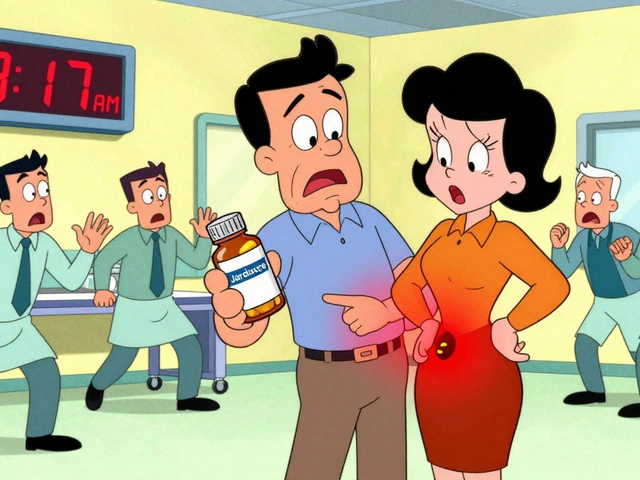
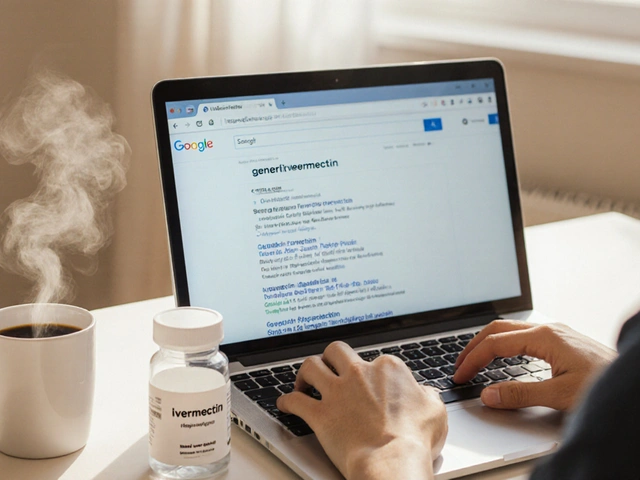
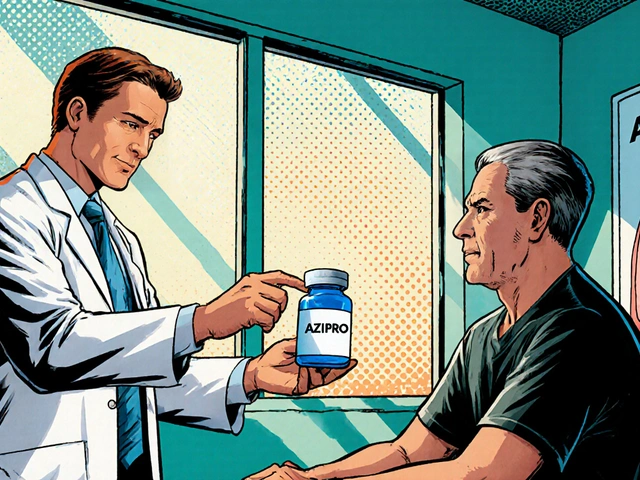
Nikhil Chaurasia
November 24, 2025Just found this tool yesterday and holy cow, it's like finding a needle in a haystack… but the haystack was on fire and someone handed me a magnet. I was trying to track down every drug with "acute liver injury" in the boxed warning for a paper, and FDALabel spit out 66 results in 3 seconds. No PDFs. No guessing. Just raw, clean, FDA-approved text. Game changer.
Holly Schumacher
November 25, 2025Let me be perfectly clear-this tool is not a substitute for clinical judgment, and anyone who thinks otherwise is dangerously misinformed. The FDA explicitly states it’s a search engine for labeling text, not a decision support system. If you’re using this to replace your EHR or your pharmacist’s advice, you’re not just being lazy-you’re putting patients at risk. Grammatically, this distinction matters. It’s not ‘can’-it’s ‘should not.’
Michael Fitzpatrick
November 26, 2025I’ve been using FDALabel for about a year now, mostly for pharmacovigilance work, and honestly, it’s become my go-to before I even open up PubMed. The Excel export update? Absolute lifesaver. Before, I was copy-pasting into Google Sheets like some kind of medieval scribe. Now I get a clean, timestamped, linked spreadsheet with all the metadata I need for audits. And the locked headers? I don’t know how I lived without them. I’ve even started sharing the permanent query links with my team-no more ‘hey can you find that one drug with the weird interaction?’ emails. It’s just… elegant. The FDA actually listened to users. That’s rare. I’m genuinely impressed.
Shawn Daughhetee
November 28, 2025just used this for the first time to check if any antidiabetics had rhabdomyolysis warnings and it worked like magic no login no bs just type and boom theres the exact line from the label wow
Miruna Alexandru
November 29, 2025It’s fascinating how this tool functions as a mirror of regulatory power. The fact that it indexes 149,000+ labels without monetization suggests a quiet, institutional form of transparency-yet it remains underutilized by clinicians because it demands epistemic labor. You must know MedDRA codes. You must understand SPL structure. You must be fluent in FDA bureaucracy. This isn’t accessibility; it’s gatekeeping dressed as utility. The Excel export doesn’t democratize access-it just makes the data easier to export into proprietary systems that still require licensing. The real question isn’t whether FDALabel works-it’s who it works for.
Justin Daniel
December 1, 2025Man, I used to hate digging through DailyMed until I found this. Now I feel like I’ve been handed the cheat code for regulatory research. And hey, to the person who said it’s not for clinical decisions-yeah, totally agree. But I use it to double-check what my EHR says, and sometimes the label says something the EMR summary missed. It’s not magic, but it’s the closest thing we’ve got to reading the FDA’s mind. Also, props to whoever coded the permanent links-that feature alone deserves a medal.
ann smith
December 2, 2025This is such a powerful resource!! 😊 I’ve been sharing it with my pharmacy students and they’re blown away. The MedDRA search alone saves hours of manual review. Thank you, FDA, for building something so useful and keeping it free. Keep up the amazing work! 🙌
Julie Pulvino
December 3, 2025Just wanted to add-when I’m comparing labeling language across SGLT2 inhibitors, FDALabel is the only tool that lets me do it fast. I used to spend days compiling PDFs. Now I can filter by class + adverse reactions + NDA and export in Excel. It’s not perfect, but it’s the most reliable source out there. Also, the July 2024 update made it way more usable. Feels like someone actually listened to users. Hope they keep improving it.
Patrick Marsh
December 4, 2025Use FDALabel. Not Drugs@FDA. Not DailyMed. This is the real deal.